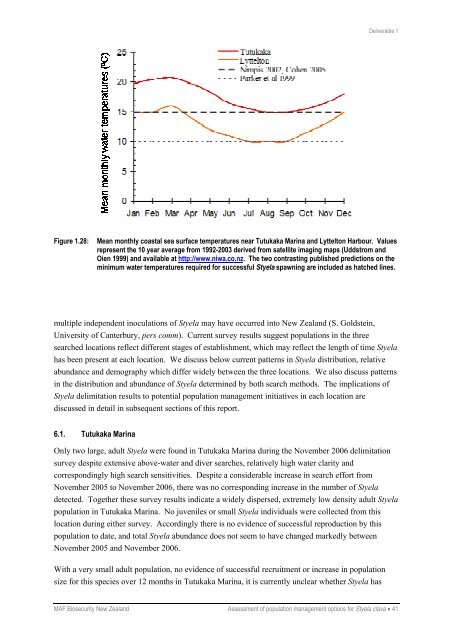Assessment of population management options for Styela clava
Assessment of population management options for Styela clava
Assessment of population management options for Styela clava
Create successful ePaper yourself
Turn your PDF publications into a flip-book with our unique Google optimized e-Paper software.
Deliverable 1<br />
Figure 1.28: Mean monthly coastal sea surface temperatures near Tutukaka Marina and Lyttelton Harbour. Values<br />
represent the 10 year average from 1992-2003 derived from satellite imaging maps (Uddstrom and<br />
Oien 1999) and available at http://www.niwa.co.nz. The two contrasting published predictions on the<br />
minimum water temperatures required <strong>for</strong> successful <strong>Styela</strong> spawning are included as hatched lines.<br />
multiple independent inoculations <strong>of</strong> <strong>Styela</strong> may have occurred into New Zealand (S. Goldstein,<br />
University <strong>of</strong> Canterbury, pers comm). Current survey results suggest <strong>population</strong>s in the three<br />
searched locations reflect different stages <strong>of</strong> establishment, which may reflect the length <strong>of</strong> time <strong>Styela</strong><br />
has been present at each location. We discuss below current patterns in <strong>Styela</strong> distribution, relative<br />
abundance and demography which differ widely between the three locations. We also discuss patterns<br />
in the distribution and abundance <strong>of</strong> <strong>Styela</strong> determined by both search methods. The implications <strong>of</strong><br />
<strong>Styela</strong> delimitation results to potential <strong>population</strong> <strong>management</strong> initiatives in each location are<br />
discussed in detail in subsequent sections <strong>of</strong> this report.<br />
6.1. Tutukaka Marina<br />
Only two large, adult <strong>Styela</strong> were found in Tutukaka Marina during the November 2006 delimitation<br />
survey despite extensive above-water and diver searches, relatively high water clarity and<br />
correspondingly high search sensitivities. Despite a considerable increase in search ef<strong>for</strong>t from<br />
November 2005 to November 2006, there was no corresponding increase in the number <strong>of</strong> <strong>Styela</strong><br />
detected. Together these survey results indicate a widely dispersed, extremely low density adult <strong>Styela</strong><br />
<strong>population</strong> in Tutukaka Marina. No juveniles or small <strong>Styela</strong> individuals were collected from this<br />
location during either survey. Accordingly there is no evidence <strong>of</strong> successful reproduction by this<br />
<strong>population</strong> to date, and total <strong>Styela</strong> abundance does not seem to have changed markedly between<br />
November 2005 and November 2006.<br />
With a very small adult <strong>population</strong>, no evidence <strong>of</strong> successful recruitment or increase in <strong>population</strong><br />
size <strong>for</strong> this species over 12 months in Tutukaka Marina, it is currently unclear whether <strong>Styela</strong> has<br />
MAF Biosecurity New Zealand <strong>Assessment</strong> <strong>of</strong> <strong>population</strong> <strong>management</strong> <strong>options</strong> <strong>for</strong> <strong>Styela</strong> <strong>clava</strong> • 41
















